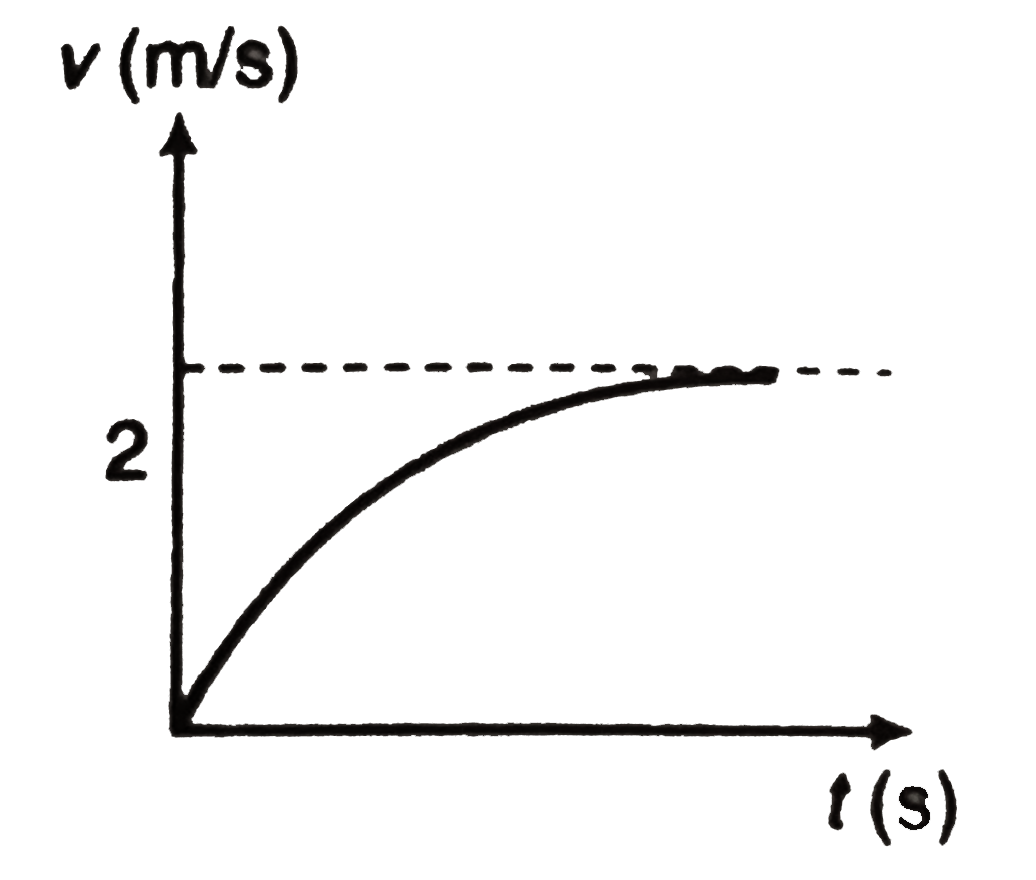Equation of motion of a body is where v is the velocity in and t is the time in second. Initial velocity of the particle was zero. Then,
the initial rate of change of acceleration of the particle is
the terminal speed is
Both (a) and (b) are correct
Both (a) and (b) are wrong
The correct Answer is:B
Further,
Solving this equation we get,

Hence, v-t graph is exponentially incresing graph,
terminating at 2 m//s.
Topper's Solved these Questions
- BOOK - DC PANDEY ENGLISHCHAPTER - KINEMATICSEXERCISE - More Than One Correct6videos
KINEMATICS
- BOOK - DC PANDEY ENGLISHCHAPTER - KINEMATICSEXERCISE - Comprehension7videos
KINEMATICS
- BOOK - DC PANDEY ENGLISHCHAPTER - KINEMATICSEXERCISE - Objective45videos
KINEMATICS
- BOOK - DC PANDEY ENGLISHCHAPTER - GRAVITATIONEXERCISE - (C) Chapter Exercises45videos
GRAVITATION
- BOOK - DC PANDEY ENGLISHCHAPTER - KINEMATICS 1EXERCISE - INTEGER_TYPE15videos
KINEMATICS 1
Similar Questions
The velocity of a particle is zero at time t = 2s, then
View SolutionThe motion of a particle moving along x-axis is represented by the equation dvdt=6−3v, where v is in m/s and t is in second. If the particle is at rest at t = 0 , then
View SolutionA particle moves along the x-axis obeying the equation x=t(t−1)(t−2), where x is in meter and t is in second
a. Find the initial velocity of the particle.
b. Find the initial acceleration of the particle.
c. Find the time when the displacement of the particle is zero.
d. Find the displacement when the velocity of the particle is zero.
e. Find the acceleration of the particle when its velocity is zero.View SolutionThe motion of a body is given by the equation dvdt=4−2v, where v is the speed in m/s and t in second. If the body was at rest at t = 0, then find
(i) The magnitude of initial acceleration
(ii) Speed of body as a function of timeView SolutionPower of the only force acting on a particle of mass m=1 kg moving in straight line depends on its velocity as P=v2 where v is in m/s and P is in watt. If initial velocity of the particle is 1m/s, then the displacement of the particle in ln2 second will be :
View SolutionThe velocity time relation of a particle is given by v =(3t2−2t−1)m/s Calculate the position and acceleration of the particle when velocity of the particle is zero . Given the initial position of the particle is 5m .
View SolutionThe instantaneous velocity of a particle moving in a straight line is given as a function of time by: v=v0(1−(tt0)n) where t0 is a constant and n is a positive integer . The average velocity of the particle between t=0 and t=t0 is 3v04.Then , the value of n is
View SolutionThe motion of a body is given by the equation dv/dt=6−3v, where v is in m//s. If the body was at rest at t=0
(i) the terminal speed is 2m/s
(ii) the magnitude of the initial acceleration is 6m/s2
(iii) The speed varies with time as v=2(1−e−3t)m/s
(iv) The speed is 1m/s, when the acceleration is half initial valueView SolutionAcceleration of a particle is given by
a=1/V
Where V is the velocity . Find
(i) Velocity of particle at time t, given that v = 10 m/s at t = 0.
(ii) Velocity of particle when its position is x, given that speed is 3 m/s at x = 0.View SolutionA particle traversed half of the distance with a velocity of V0.The remaining parts of the distance was covered with velocity V1, for half of the time and with V2 for other half of the time .Find the mean velocity of the particle averahed and the whole time of motion .
View Solution

